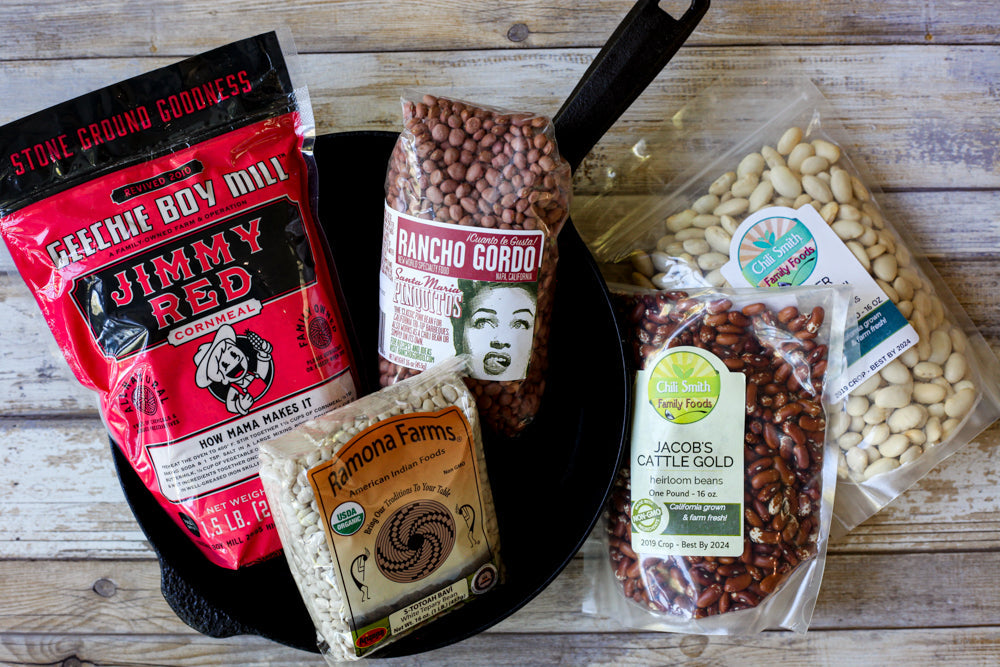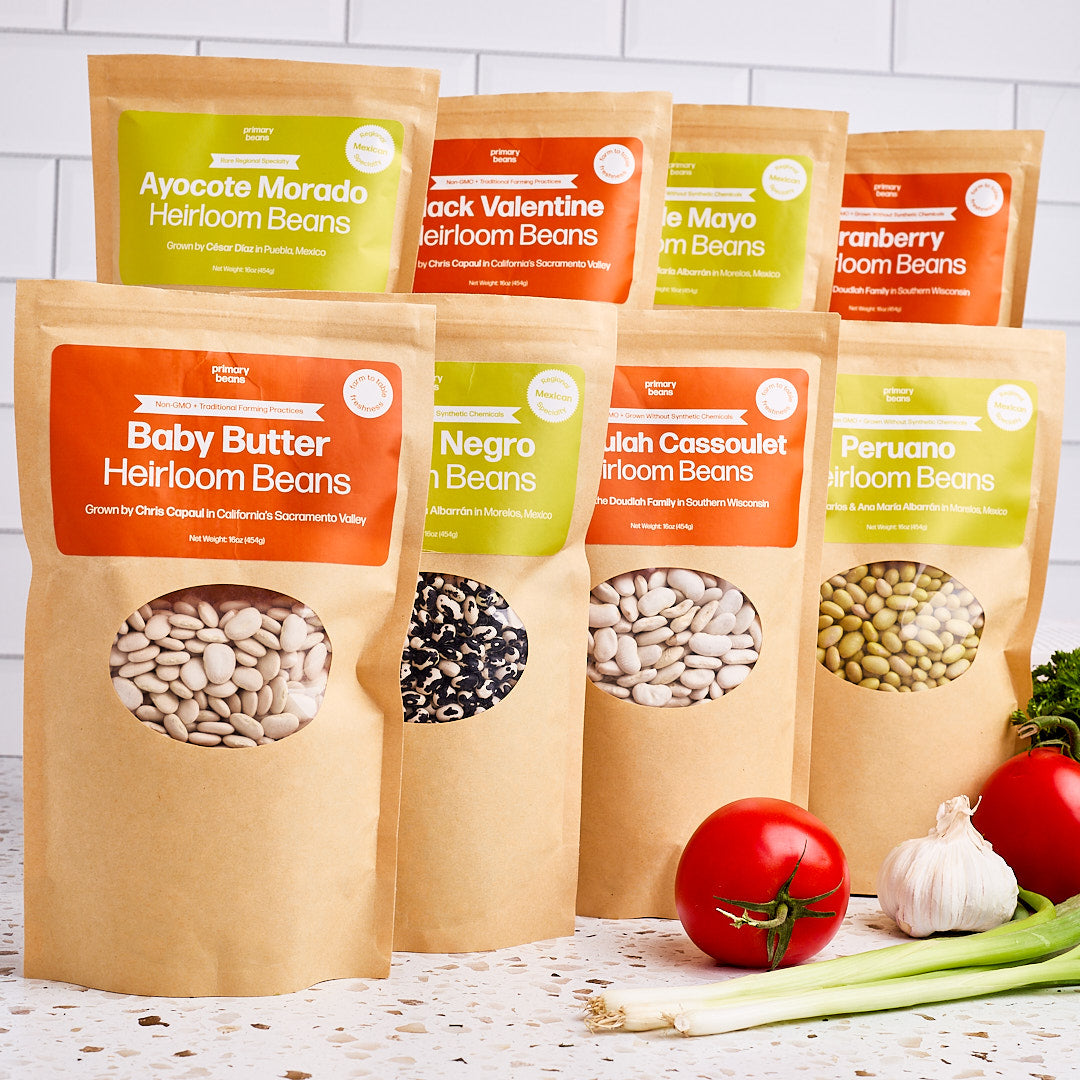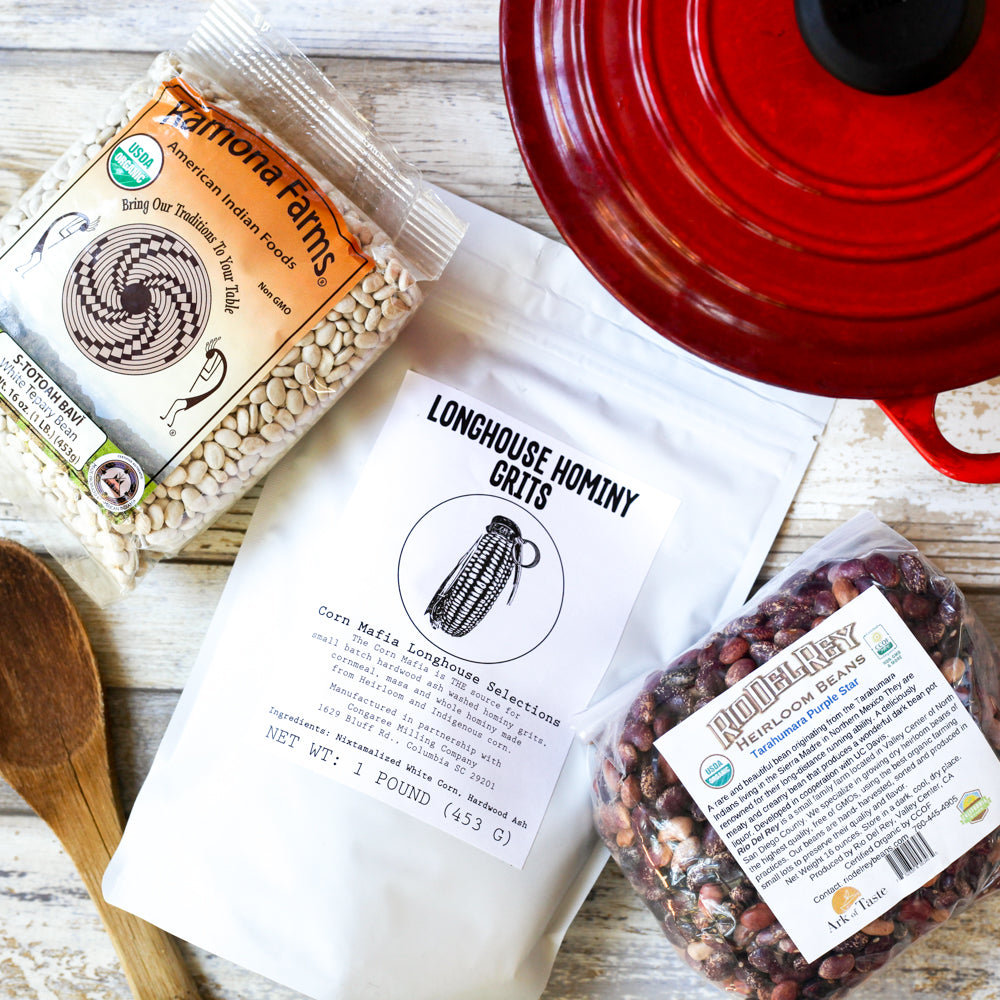10.99 FLAT RATE SHIPPING
10.99 FLAT RATE SHIPPING
SHOP

July Heirloom Bean and Grain Club
June 28, 2021 7 min read
The Heirloom Bean and Grain Club box for July contains hand selected, rare varieties perfect for all those summer salads, easy vegan meals and BBQ sides. We don't know about you, but we're ready to see our friends in the back yard and enjoy some easy entertaining. From heirloom, non-GMO cornmeal for the best cornbread ever, to a big pot of Santa Maria Style Pinquitos to go with whatever you're throwing on the grill we hope that this box will fill the dog days of summer with joy and good food.

Family Box Includes
White Tepary Beans by Ramona Farms
Santa Maria Style Pinquito Beans from Rancho Gordo
Jimmy Red Cornmeal by Geechie Boy Mill
Cannellini Beans by Chili Smith
Jacob's Cattle Beans by Chili Smith
Small Box Includes
White Tepary Beans by Ramona Farms
Santa Maria Style Pinquito Beans from Rancho Gordo
Jimmy Red Cornmeal by Geechie Boy Mill
WHITE TEPARY BEANS
These organic heirloom beans are the original superfood of the Sonoran Desert having sustained Native American people for countless generations. Highly acclaimed for it's nutritional value the stotoah bavi (white tepary bean) is noted for its unique and delicious naturally sweet yet savory flavor and creamy texture. The white tepary bean make delicious hummus, soups, salads, dips and spreads.
Ramona Farms shares with us their traditional foods grown on the ancestral lands of the Akimel O'Odham (Gila River Pima) tribe in Arizona's Sonora Desert. An ingredient in the Slow Food Ark of Taste, the tepary bean is believed to be the world’s most drought tolerant bean, and higher in fiber and protein than most other beans with a low glycemic index and superior taste.

ABOUT THE FARMER
We are honored that Ramona is sharing with us the food traditions of her tribe, the Akimel O'Odham (Gila River Pima) Community. Ramona's father, Francisco ‘Chiigo’ Smith, an O’dham farmer, grew many traditional crops on the Gila River Indian Reservation in Arizona. Her mother was an herbalist and traditional healer. Together they taught Ramona the value of their traditional foods and way of life. She continued the traditions with her own family, farming on this ancestral land with her husband.
In the late 1970’s, some community elders asked Ramona and her husband us to grow the Bafv (tepary bean), which had nearly become extinct due to the lack of water that put many of the local subsistence farmers out of business. They discovered that her father had left a few seeds of the white and brown tepary beans in glass jars in a trunk in the old adobe house that she grew up in. They knew that it was to become their mission to ‘bring the bafv back’ to the community.
The tepary bean is part of the Slow Food Ark of Taste and its roots go back thousands of years in our native foodways. The remains of the tepary have been found in archeological sites in Mexico that are 5,000 years old and it has been grown in what is now California and Arizona for thousands of years. This incredibly hearty bean was a staple food source for Native American tribes who cultivated it to survive in the incredibly arid conditions.
It is through Ramona's tireless efforts that we can now enjoy this delicious part of our American cultural heritage and honor the traditions of the Akimel O'Odham people and their ancestors that have cared for the land for generations.

CREAMY WHITE TEPARY BEAN HUMMUS
- 1 cup dry tepary beans
- 1 lemon
- 1/4 cup tahini
- 1 garlic clove chopped fine.
- Kosher salt
- Fresno Chili Crush Olive Oil (optional)
Cook the tepary beans in a pressure cooker or stovetop until very soft (45 minutes in pressure cooker). Strain the beans reserving the liquid and put them in a blender. Add lemon juice and tahini. Place the chopped garlic on a cutting board and sprinkle with kosher salt. With the back of your knife mash the garlic and salt into a paste and add to the blender. Add 2 tablespoons of the bean cooking liquid to the blender and blend on high speed. Add more bean liquid until you reach your desired consistency.
WAYS TO ENJOY THEM
We make hummus all summer long both with and without tahini but we also love these slightly sweet little beans in salads like this one from Kylee Cooks. When we don't mind a little heat in the kitchen this mouthwatering Tepary bean and Fennel Ragout makes great use of an abundant summer garden.
SANTA MARIA PINQUITOS
If California had a state bean, it would be the pinquito. These flavorful little pink beans come exclusively from California's Central Coast and are traditionally served with the barbecued tri-tip that made the Santa Maria region famous. They are considered the essential side dish ladled into large bowls full of bothy goodness.

There are many legends about how these diminutive legumes arrived here in the golden state. Some say Spanish cowboys brought them here, others say migrant farm workers brought them into the state. Another, somewhat official version, says that in the 50s a local farmer got his hands on some from Mexico and convinced one of the town restaurants that they'd be a good addition to the menu.
The beans are meaty in texture and they hold their shape even after hours of cooking but it's the flavor that keeps everyone coming back. Generations later they are still being prepared by that same Santa Maria restaurant and still being grown by that same family farm. You'll find dozens of recipes for Santa Maria Pinquitos online but at Jacko's they prepare them very simply with a bit of

bacon, onion, garlic, salt an a little chili, simmered low and slow for 5 to 6 hours on the stove. Get the original recipe from Jacko's as printed in the Los Angeles Times HERE. Down the road a stretch in Solvang, California The Alisal Guest Ranch and Resort makes their own version of Piquitos. It's more like a West Coast answer to New England baked beans, with mustard powder and brown sugar. You'll find it here reprinted by Food & Wine Magazine. They are equally good without the pork for a vegan version of the dish and we love this recipe for vegan quinoa and pinquito tacos from Fat Free Vegan Kitchen.
JIMMY RED CORNMEAL
This delicious Ark of Taste heirloom cornmeal is sweeter, fresher and more flavorful than conventional brands. Jimmy Red is a bright red corn with a colorful history and a celebrated reputation with chefs. Thanks to chefs like Sean Brock it has burst onto the culinary scene and is adorning restaurant menus throughout the US.
Now protected in the Slow Food Ark of Taste, Jimmy Red was a Native American corn that made its way south to Florida, Georgia and the South Carolina Islands where it was largely used to create moonshine. It was not well known outside of bootlegger circles until the last of the bootleggers passed away and nearly took Jimmy Red with him. Lucky for us someone saved a couple of ears and gave them to a celebrated farmer and seed saver who found that this unique variety was good for much more than hooch. He gave seeds to several small farmers including Geechie Boy Mill who makes spectacular grits and cornmeal with the grain.
Why all the fuss? Jimmy Red is a distinctly unique corn with a nutty aroma and a personality all it's own. It has been said that tasting grits made of Jimmy Red is like tasting what grits must have tasted like in the 1800s.

ABOUT THE FARMER
Greg Johnsman is passionate about preserving traditional Southern foodways on the South Carolina Sea Islands. He and his wife Betsy farm and mill heirloom grains on Edisto Island, where Betsy's family has farmed for generations. Their antique grist mills preserves the natural oils of the corn, resulting in highly flavorful grits. Greg mills each batch of grits to order, supplying James Beard restaurants across the US with the finest grits and grains available.
Last year the couple decided to give up the brand name they had inherited when they purchased the mill and they are in the process of changing the name to one that they hope would not cause discomfort or harm, Marsh Hen Mills. The Gullah Geechee are descendants of African slaves who settled in coastal areas of the Carolinas, Georgia and Florida. In recent months the couple heard criticism that the name was not appropriate for a white farmer and they took it to heart. A name change is not only a major cost, it also risks a loss in business for a young brand. We fully support the Johnsman's in this choice and we thank you for continuing to support small family farms like theirs.

JIMMY RED HOE CAKE
2 Cups Jimmy Red Cornmeal
1 teaspoon kosher salt
1 teaspoon sugar
1/4 teaspoon baking powder
1 cup buttermilk (or whole milk) 1 cup water
butter, green onions and syrup for serving
In a large bowl combine the cornmeal, salt, sugar and baking powder.
Pour the milk and water into a sauce pan and heat until small bubbles start to form around the edge of the pan.
Immediately pour the heated milk mix into the cornmeal mixture and whisk together until the batter is smooth.
Add butter or bacon fat to a cast iron skillet and heat to medium high. Spoon the batter onto a hot skillet, forming 3-inch cakes and being careful not to crowd the pan. Cook 3-4 minutes preside until golden brown.
Serve immediately with butter and chopped green onion on top. Serve with maple syrup. (we suggest Bob’s Finest Kind Smoked Maple Syrup.)
JACOB'S CATTLE BEANS
This striking gold colored version of Jacob's Cattle Bean is a rich, nutty flavored bean that is boasts shorter cooking times and less need to soak before cooking. Also called “Cowboy Beans,” the bright gold color with the patches of white make a pretty pot of beans and are super with meats, sauces and in chili or salads.
Jacob's Cattle Bean is an ingredient in the Slow Food Ark of Taste that originates in the Northeastern US and Canada. The gold is often described as a bit more tender than the traditional maroon colored Jacob’s Cattle bean but both are equally delicious.

SMOKY VEGAN BAKED BEANS
You won't believe there's no sugar or bacon in these mouthwatering baked beans! Once you've tried them, you'll never open a can again. They do take a bit of time, but you'll be able to brag about how you slowly developed flavors for hours at the 4th of July Barbecue. Get the Recipe here.
CANNELLINI BEANS
The cannellini bean is a white kidney bean developed in Argentina and brought to Itally where it became incredibly popular in dishes like pasta e fagioli and minestrone. It is particularly popular in Tuscany. Due to its large size and meaty texture it takes a bit longer to cook.
TUSCAN TOAST WITH CHILI OIL
Crispy toast with creamy white beans, chard and a drizzle of fresno chili oil is perfect served with a chilled glass of rosé on a summer afternoon. This delectable plant based dish is so hearty you could have it for dinner or cut the toast into smaller pieces and serve as an appetizer. Omit the parmesan cheese to make this vegan. Get the Recipe >>
Recent Articles
About Us
Foodocracy is dedicated to creating a more sustainable and independent food system. We support small, independent farms across the nation.
Get impossible to find beans and grains shipped direct to your doorstep each month from small family farms.
We support small, family owned farms across the nation. Did you know that farmers only make an average of 10 cents on every dollar you spend at the supermarket? Working directly with farms and not middle men ensures that more money goes back to the people actually growning your food.
Get 10% Off
Sign up for delicious recipes and special offers.
**Regularly priced items only.





